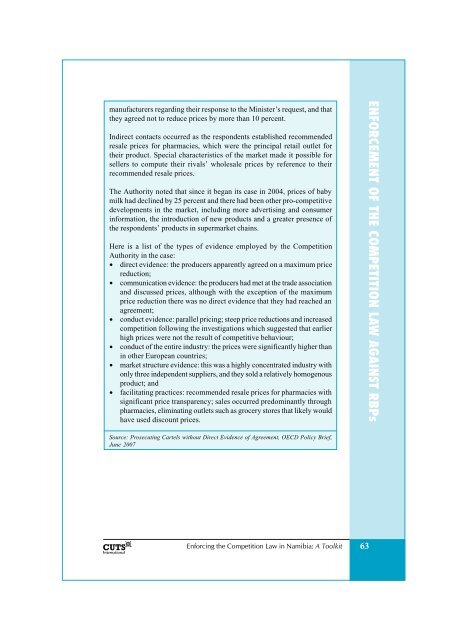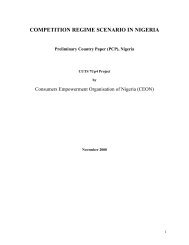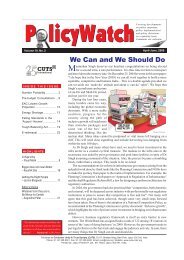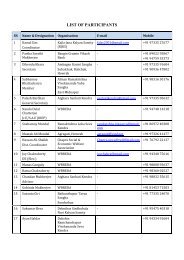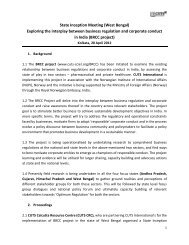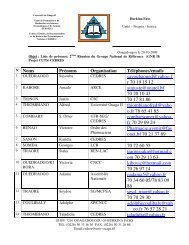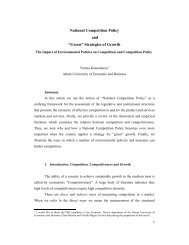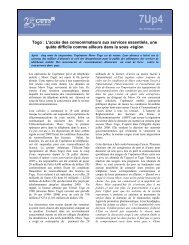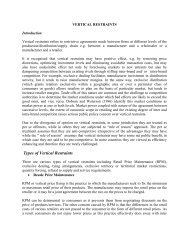Enforcing the Competition Law in Namibia A Toolkit - cuts ccier
Enforcing the Competition Law in Namibia A Toolkit - cuts ccier
Enforcing the Competition Law in Namibia A Toolkit - cuts ccier
Create successful ePaper yourself
Turn your PDF publications into a flip-book with our unique Google optimized e-Paper software.
manufacturers regard<strong>in</strong>g <strong>the</strong>ir response to <strong>the</strong> M<strong>in</strong>ister’s request, and that<strong>the</strong>y agreed not to reduce prices by more than 10 percent.Indirect contacts occurred as <strong>the</strong> respondents established recommendedresale prices for pharmacies, which were <strong>the</strong> pr<strong>in</strong>cipal retail outlet for<strong>the</strong>ir product. Special characteristics of <strong>the</strong> market made it possible forsellers to compute <strong>the</strong>ir rivals’ wholesale prices by reference to <strong>the</strong>irrecommended resale prices.The Authority noted that s<strong>in</strong>ce it began its case <strong>in</strong> 2004, prices of babymilk had decl<strong>in</strong>ed by 25 percent and <strong>the</strong>re had been o<strong>the</strong>r pro-competitivedevelopments <strong>in</strong> <strong>the</strong> market, <strong>in</strong>clud<strong>in</strong>g more advertis<strong>in</strong>g and consumer<strong>in</strong>formation, <strong>the</strong> <strong>in</strong>troduction of new products and a greater presence of<strong>the</strong> respondents’ products <strong>in</strong> supermarket cha<strong>in</strong>s.Here is a list of <strong>the</strong> types of evidence employed by <strong>the</strong> <strong>Competition</strong>Authority <strong>in</strong> <strong>the</strong> case:• direct evidence: <strong>the</strong> producers apparently agreed on a maximum pricereduction;• communication evidence: <strong>the</strong> producers had met at <strong>the</strong> trade associationand discussed prices, although with <strong>the</strong> exception of <strong>the</strong> maximumprice reduction <strong>the</strong>re was no direct evidence that <strong>the</strong>y had reached anagreement;• conduct evidence: parallel pric<strong>in</strong>g; steep price reductions and <strong>in</strong>creasedcompetition follow<strong>in</strong>g <strong>the</strong> <strong>in</strong>vestigations which suggested that earlierhigh prices were not <strong>the</strong> result of competitive behaviour;• conduct of <strong>the</strong> entire <strong>in</strong>dustry: <strong>the</strong> prices were significantly higher than<strong>in</strong> o<strong>the</strong>r European countries;• market structure evidence: this was a highly concentrated <strong>in</strong>dustry withonly three <strong>in</strong>dependent suppliers, and <strong>the</strong>y sold a relatively homogenousproduct; and• facilitat<strong>in</strong>g practices: recommended resale prices for pharmacies withsignificant price transparency; sales occurred predom<strong>in</strong>antly throughpharmacies, elim<strong>in</strong>at<strong>in</strong>g outlets such as grocery stores that likely wouldhave used discount prices.ENFORCEMENT OF THE COMPETITION LAW AGAINST RBPsSource: Prosecut<strong>in</strong>g Cartels without Direct Evidence of Agreement, OECD Policy Brief,June 2007<strong>Enforc<strong>in</strong>g</strong> <strong>the</strong> <strong>Competition</strong> <strong>Law</strong> <strong>in</strong> <strong>Namibia</strong>: A <strong>Toolkit</strong> 63


